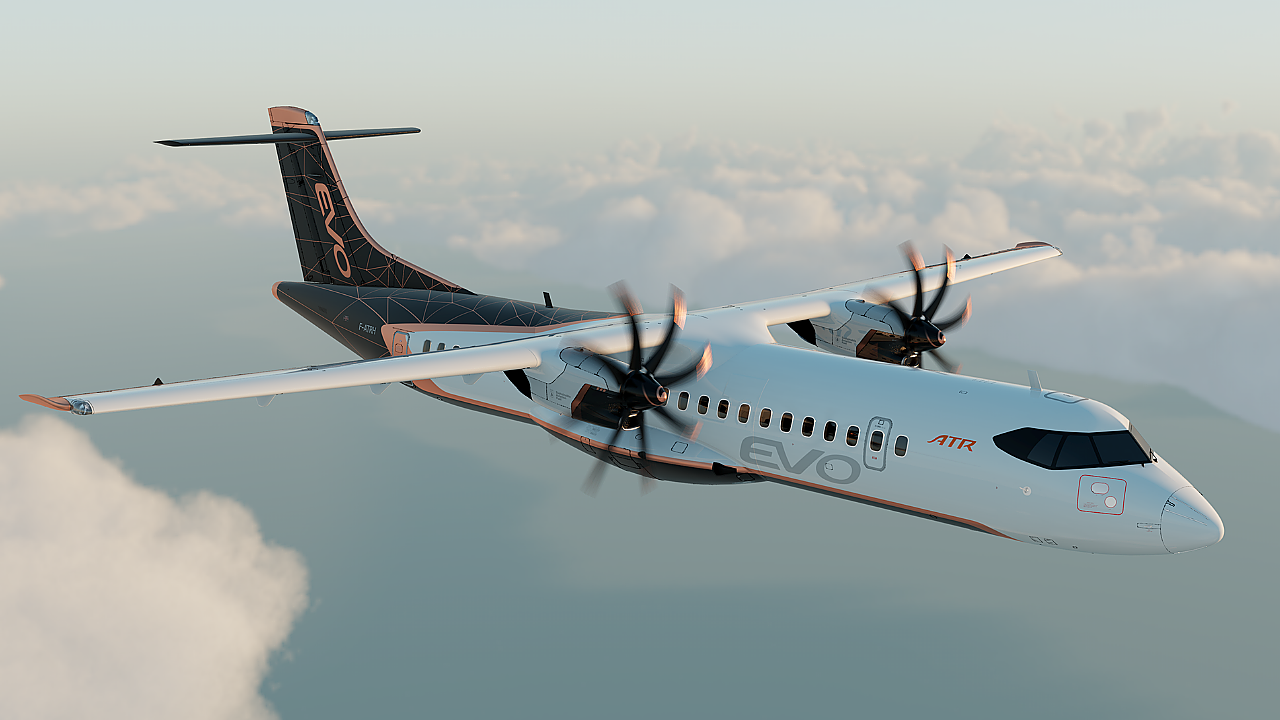
ATR has unveiled plans for the next generation of its regional transport aircraft (RTA) offerings with the all-new ATR ‘EVO’. The European airframer will formally launch the programme next year, with a 2030 target for entry into the market, by prioritising improved operating economics and greater sustainability with the new ‘EVO’ aircraft RTA family.
“Our next generation of aircraft will be a step forward in responsible flying through further incremental innovation,” said ATR CEO Stefano Bortoli. “When it enters the market, the new ATR ‘EVO’ will pave the way towards a decarbonised future for aviation. Key benefits include a 20% overall fuel improvement and 100% SAF compatibility. This means that the aircraft will emit over 50% less CO2 than a regional jet when powered by kerosene. When using 100% SAF, its emissions will be close to zero.”
Ready For Takeoff
The new ATR ‘EVO’ appears largely similar to its market-leading predecessors and will remain a twin-engine turboprop RTA. However, it will feature advanced design features and a new powerplant with hybrid-electric capability. ATR is working closely with airlines, engine manufacturers, and systems providers to finalise the aircraft’s specifications for the programme's official launch next year. Stéphane Viala, SVP, Engineering, ATR, said that the airframer had already requested information from the main engine manufacturers to develop the new powerplant to combine existing and future generation engine technology. It has been working for quite a while to assess which advanced technologies need to be integrated into the aircraft, said Viala.
The new powerplant will feature an eight-bladed propellor design to help improve performance while reducing noise. Viala said the aircraft’s ‘Karman’ shape was also being optimised, and all junctions between shapes are rounded to benefit from modern aerodynamics tools in reducing overall drag. “We are also looking to benefit from new technology for de-icing, replacing the mechanical boots with an electrical solution,” Viala said.
The ATR EVO is expected to significantly improve performance, economics and sustainability over the previous generation. Airline operators will benefit from the new aircraft’s improved time to climb performance, allowing it to get to operating altitudes quicker and deliver better performance at ‘hot and high’ airports/airfields. Recyclability will be at the heart of the new aircraft’s design, and the cabin will feature increased use of lighter bio-sourced materials.
According to Fabrice Vautier, ATR SVP Commercial, the ATR ‘EVO’ will deliver double-digit operating cost savings through 20% lower fuel burn and 20% overall maintenance cost reduction. “This means airlines can serve thin routes more profitably, and communities can benefit from more connectivity, more essential services, and more economic development. Our aim is to continue to offer customers and society ever more inclusive and responsible air transportation.”
ATR has pledged to reach net-zero emissions by 2050 and views the use of 100% SAF as one way of achieving it. It inked a letter of intent with Sweden’s Braathens Regional Airlines in September 2021 to accelerate the introduction of 100% SAF on ATR aircraft. The project aims to offer 100% SAF certification in 2025, which ATR anticipates will lead to an 82% reduction in CO2 emissions.

While turboprop RTAs remain the most sustainable commercial aircraft, ATR is working with its airline customers to understand the operational impact of alternative propulsion solutions. According to the airframer, by supporting customers into the future through an incremental approach, it can incorporate future disruptive technologies while constantly improving its platform by offering the latest upgrades and solutions. One such offering is the incorporation of Performance-Based Navigation (PBN), which directly impacts fuel consumption as it plots the optimal route for the pilot to follow.
New Powerplant
With the new ATR ‘EVO,’ the airframer is working on improvements to its existing RTA fleet. Last November, it announced that it would introduce Pratt & Whitney Canada’s new PW127XT engine to its ATR 72 and 42 families.
According to a company official, there is strong interest in this engine because it delivers a 3% reduction in fuel burn and a 20% reduction in maintenance costs. For airline operators, who witness their razor-thin operating margins evaporate during oil price spikes, the best hedge against higher fuel prices is to operate aircraft that burn less fuel. Hence, a 3% improvement in fuel efficiency can significantly impact an airline’s bottom line.
The new engine offers a 40% extended time on the wing with increased engine overhaul time to 20,000 hours; therefore, the PW127XT aircraft will have only two scheduled engine events over ten years, operating on typical mission lengths and 2,000 annual flying hours.

New Stablemate
ATR’s new 42-600S ‘Short Take-Off and Landing’ (STOL) took to the air for the first time earlier this month, marking an important milestone in the programme. The aircraft made the test flight in its partial configuration in a flight lasting two hours and 15 minutes. The test aircraft is an ATR 42-600 prototype (MSN 811) converted into a 42-600S STOL variant. The prototype aircraft will now be used for ground and flight tests. It will be modified into its final configuration by the end of the year (with the incorporation of a larger rudder) and will make its maiden flight in 2023.
ATR had to slightly readjust its development schedule due to COVID-19. “We have successfully passed a major step in aircraft development, called ‘Maturity Gate 7’, which means that the aircraft design is frozen, the expected performance is confirmed, and industrialisation has begun, a company official said. The new 30-50 seater aircraft features equipment integrated for the first time on ATR aircraft, such as the Multifunctional Computer New Generation (MFC-NG), followed by the autobrake, ground spoiler, and increased take-off rating systems.
The ATR 42-600S has received 20 commitments from airlines and lessors, and the airframer views several markets in the region as ideal for the ATR 42-600S, including Indonesia, the South Pacific, Papua New Guinea and Japan. The aircraft will be ideally suited for operations from nearly 500 airports across the globe, which have runway lengths between 800-1,000 meters.